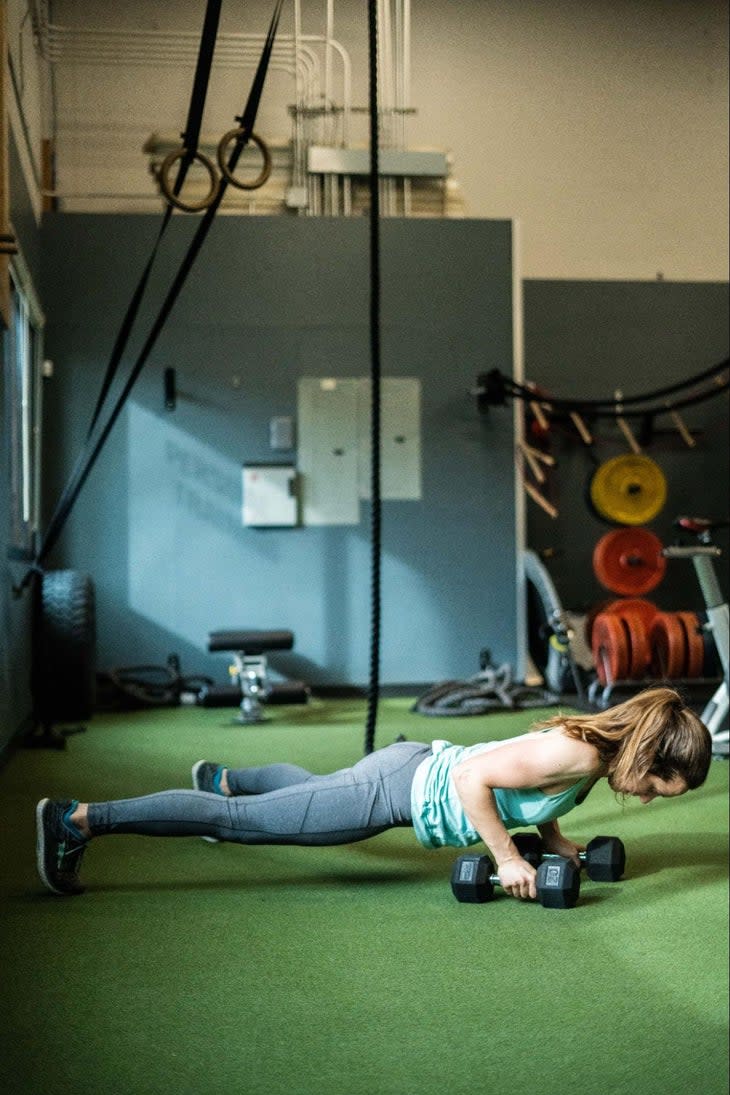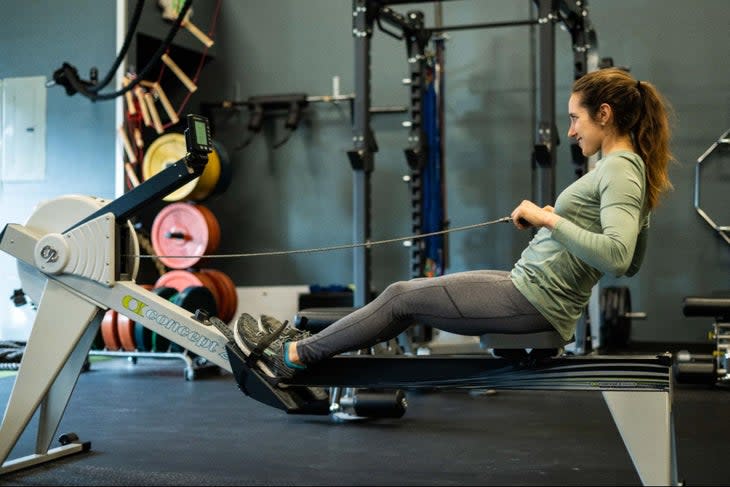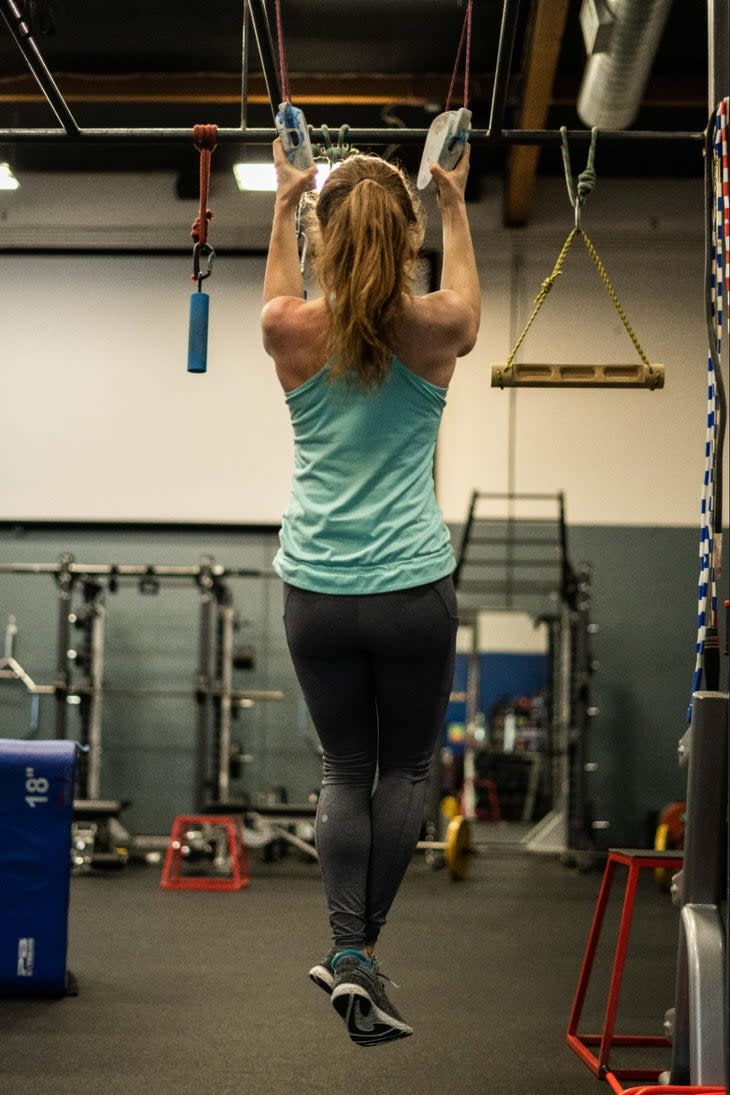Could flywheel training be the key to getting stronger? Here’s the science.
This article originally appeared on Trail Runner
The majority of runners I know have to be pushed, pulled, and prodded into doing strength training - after all, we like to spend our leisure time doing what we love most: running. For many of us, we'd rather walk into the dentist for a root canal than get under the squat rack or hammer out a sad set of push-ups.
One of the biggest reasons runners may not see results from their strength training is often that they aren't doing it inconsistently, or aren't lifting heavy enough. But what if there was a method that provided effective, efficient results - in less time, and with more bang for our buck?
Before you write this off as the latest trend to scoff at, hear me out: I had not heard of flywheel training prior to researching this article. I set out to write an article on the best forms of strength for runners, and found myself faced with a new method I had yet to dive into. Several research studies later, I found that flywheel training holds a lot of genuine potential. Although the concept has been out there for a while, it hasn't yet become prominent in the sports performance space, particularly as it relates to running. Let's dive into the science behind flywheel training.
RELATED: Strength Training 101
What is flywheel training?
You have likely heard of eccentric concentrations, meaning the portion of an exercise where your muscle elongates, rather than contracting (think running downhill, standing up from a squat, landing after jumping over a rock in the trail). If we think of descending downhill like jumping on a pogo stick, eccentric contractions act as a series of shock-absorbing springs for our muscles with each landing. (Just don't get any ideas about pogo sticking your way to the next finish line).
Flywheel training centers around this principle and incorporates variable resistance through slower movement and constant contractions. This means muscles are continuously under load while the exercise is performed at a slower cadence. This leads to a longer total time under tension for the muscles you're working.

For instance, imagine you are performing a set of squats. Whereas we normally load up a barbell or grab a dumbbell, perform a quick set of repetitions, and allow for a slight pause at our top (standing) position, taking a flywheel approach would involve continuous movement, while slowing down each repetition to truly "feel the burn" with each exercise. You might lower for five seconds rather than the normal one or two, which is essentially performing a "negative" repetition. For resistance, you might hold a cable beneath you (weighing you down towards the floor) or wrap a weighted belt around your waist, forcing yourself to propel upward from beneath with more strength and stamina.
RELATED: Train To Be A Stronger Downhill Runner
In case you are wondering just how challenging that is, try lifting yourself in a push-up as slowly as you can (resting hands at the bottom of the movement, while your chest touches the ground, rather than the top). Or try lowering yourself from a pull-up bar as slowly as your arms will allow. Chances are, both will feel more challenging than the conventional route most of us have taken.
What's the science behind a flywheel approach?
Now that we have established what flywheel training is, let's dive into the juicy good stuff: the data. A 2019 study in the Journal of Strength and Conditioning Research compared three groups of both elite and recreational runners who did one strength session each week of either high intensity training, low intensity training, or flywheel training. The flywheel group recorded maximum velocity (Rating of Perceived Exertion of 9 or 10 on a 10-point scale) using a Yo-Yo Leg Press, an innovative system from Sweden that maximizes the eccentric phase of muscle contraction. Talk about cool!
Before and after the 8-week study, researchers measured maximal oxygen uptake (AKA, VO2max), first and second ventilatory thresholds (VTs), maximal dynamic force (1 repetition maximum or 1RM), and anthropometric data through a DEXA scan (covering muscle percentage within the body). The flywheel strength group showed significant increases in dynamic force (12.1% improvement of 1RM) and running economy compared to the conventional strength training methods.
These improvements are attributed to an increase in muscle strength, mainly because of the eccentric component, considered one of the major determining factors of running economy for endurance performance. The running economy benefits through flywheel strength training were proportional to race duration, with no difference for high intensity training in 2K and slightly more benefit over 10K, indicating potential for much higher impact over longer distances like marathons or ultras.
If you're wondering whether there was an impact on muscle size, take note: there were no measured changes in the muscle composition of lower limbs for the flywheel strength group. For one, that means you probably won't "bulk up" through quality strength sessions. It also means the strength gains of the flywheel group were not due to structural changes in muscles; instead, they came from neural adaptations such as increased activation, more efficient muscle recruitment, motor unit synchronization, and motor neuron excitability. In other words, flywheel training increases the capacity to store and reuse elastic muscle energy, which seems to have a protective effect against muscle damage that occurs through high volumes of downhill running and racing.

As the authors note, these findings have never been demonstrated before. I repeat: NEVER demonstrated before, in terms of flywheel's protective effect for running performance markers like elastic muscle energy. If that's not enough for you to start chasing after flywheel, I don't know what is!
This finding aligns with other studies: just 1-2 sessions per week of 4-6 exercises can significantly boost running performance (if you love research, check out this systematic review). On the contrary, the high and low intensity training groups did not show any significant improvements in running economy. While there is extensive science suggesting various forms of strength training can improve our running economy, performance metrics and help us prevent injury, this is the first that showed a direct correlation between muscle force and running economy.
Before we fly into next steps, let's agree on the best thing about this form of strength training: you don't need much to reap results. For many runners who would rather spend our time running, this is great news:
4-7 sets of 7 repetitions of a single exercise, performed 3 times per week for 8 weeks, can significantly improve running economy and eccentric load capacity in recreational runners.

How do I incorporate flywheel methods into my own training?
Here's a sample workout of flywheel-style exercises. Select a few exercises and do 4-5 sets of 6-8 repetitions of each. Start with 1-2 days per week if you're doing a full routine, or bump up to three weekly workouts if you'd rather just do a single exercise or two.
Note: this will feel different at first, and perhaps leave you feeling more sore than usual. However, it's all part of the process of trying something new. Take it easy, and as always, be aware of any unusual levels of pain beyond muscle soreness.
RELATED: It's Normal To Be Sore In The Morning
Main ingredients:
Eccentric split squats or lunges (start from the bottom position, slowly press up, and finish standing)
Pull-up negatives (hop up to the bar, hold, and slowly lower, then start at the top again)
Eccentric hamstring curls (extend your legs away from you at a much slower rate than you bring your heels in)
Hand-release pushups (lifting yourself off the floor with elbows in and your chest on the ground). To make it tougher add a resistance band around your torso, attached to the floor or beneath your hands.
Optional condiments:
Eccentric single leg calf raises (slowly lowering your calf off a ledge)
Reverse crunches (lie on your back, lift your hips and very slowly lower them back down)
Any plyometric exercise emphasizing eccentric contraction, such as pogo hops side-to-side or back-to-back
You can perform these in a circuit-style format (back-to-back), with three or more minutes between each set, or you can take each exercise one at a time, providing yourself at least 1-2 minutes between each set. Regardless, focus on nailing quality repetitions under a load you find challenging, rather than trying to fit in as many reps as possible.
If there is anything flywheel training can teach us, it's that a small dose goes a long way. Now, embrace that eccentric concentration and channel your downhill energy over to the weight room. You may find yourself reaping more benefits with little doses of strength, leaving you with more time on the trails and better performance.
For exclusive access to all of our fitness, gear, adventure, and travel stories, plus discounts on trips, events, and gear, sign up for Outside+ today.

